Roku Not Working
Roku has established itself as a leading streaming device, offering users a seamless and convenient way to access a wide range of entertainment choices. With its simple interface and vast collection of channels, Roku has become an appealing choice for cord-cutters and streaming enthusiasts alike. However, like any technology, Roku devices are not immune to issues. Many users find themselves asking, Why is Roku not working?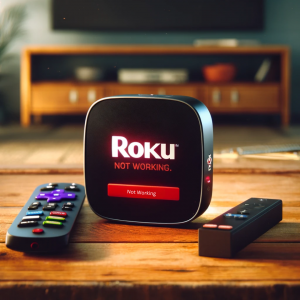
Common problems that Roku users may encounter include connectivity issues, freezing or slow performance, and difficulties with the remote control. These issues can be frustrating, especially when you’re looking forward to unwinding with your favorite show or movie. Roku not working issue is often followed by a search for solutions to get the device back up and running smoothly.
In this guide, we’ll explore Roku not working issue and provide step-by-step instructions for resolving them. By the end, you would have a clearer understanding of why is Roku not working and how to fix it.
Stay tuned as we dive into the world of Roku troubleshooting, ensuring that your streaming experience remains uninterrupted and enjoyable.
Understanding the Roku Not Working Problem
When it comes to troubleshooting for Roku, the first step is to understand the problem you’re facing. Common issues that lead to Roku not working can range from “no signal” errors to freezing and slow performance. Remote control issues are also prevalent, causing frustration for many users.
-
No Signal for Roku:
This is a common problem where your TV screen displays a “no signal” message instead of your Roku’s home screen. This issue could be due to a variety of factors, including loose cable connections or incorrect input settings on your TV.
-
Freezing and Slow Performance of Roku:
Another frequent complaint is that the Roku device freezes or performs sluggishly. This can be annoying when you try to navigate menus or stream content.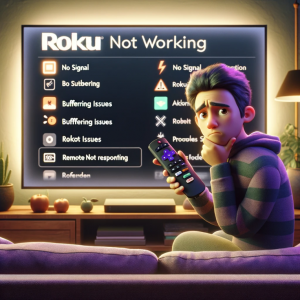
-
Roku Remote Issues:
Problems with the Roku remote can include unresponsiveness, pairing issues, or a dead battery. These issues can prevent you from controlling your Roku device effectively. If you want to know more about remote issues with Roku, you can read our in-depth blog on Roku Remote Not Working.
Identifying the specific issue is crucial for effective Roku troubleshooting. For example, if you’re experiencing no signal, checking your HDMI connections might be the first step. If your Roku is freezing, a system restart could be a quick fix. Understanding the nature of the problem will guide you toward the most appropriate solution.
Basic Roku Troubleshooting Steps
When facing issues with your Roku device, there are several basic troubleshooting steps for Roku that you can take to resolve common problems. These steps are often effective in addressing issues related to connectivity, minor glitches, and outdated software.
-
Checking the Internet Connection for Roku
A stable and strong WiFi connection is crucial for the smooth running of your Roku device. If you find that your Roku does not connect to the internet, the first step is to check your WiFi network. Ensure that your router is working properly and that your Roku device is within range. You can also try reconnecting to the network or restarting your router to refresh the connection. If the issue still continues, you can read our comprehensive blog on Roku Not Connecting To Internet.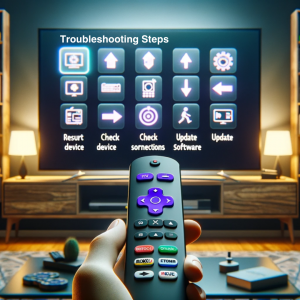
-
Restarting Your Roku Device:
Restarting your Roku can resolve many minor glitches and issues. To reboot your Roku, you can either unplug it from the power source and wait for a few seconds before plugging it back in or use the system restart option in the settings menu. This simple step can often fix problems related to slow performance. If you face the issue of unexpected restart from Roku, you can read our comprehensive blog on Roku Keeps Restarting.
-
Checking for Roku Software Updates:
To keep your Roku device up-to-date with the latest firmware is important for its optimal performance. To check for updates, navigate to the settings menu, select “System,” and then “System update.” If an update is readily available, follow the on-screen steps to install it. Regular updates can prevent many Roku not working issues, including problems with the Roku app not connecting to TV.
By following these basic Roku troubleshooting steps, you can often resolve common issues with your Roku device. If these steps do not fix the problem, you may need to explore more advanced troubleshooting techniques or seek assistance from Roku support.
Advanced Troubleshooting for Roku
When basic Roku troubleshooting steps fall short in resolving Roku device issues, exploring advanced techniques becomes necessary. These methods are particularly effective for tackling persistent challenges related to signal, performance, and remote control functionality, as well as common problems like no sound on Roku TV.
-
Resolving No Sound on Roku TV Issues
Encountering no sound on Roku TV can disrupt your streaming experience. To troubleshoot, ensure your HDMI cable is firmly connected to both your Roku device and TV. Consider trying another HDMI port on your TV or a different HDMI cable to eliminate hardware issues. Confirm that your TV is on the right input source for your Roku device. Checking these can help address the no sound on Roku TV problem effectively.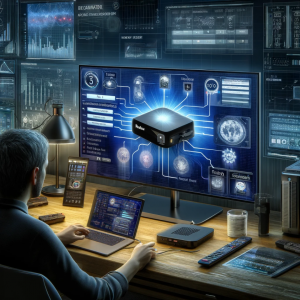
-
Addressing Roku Freezing and Slow Performance
If you’re experiencing slow performance or your Roku device is freezing, clearing the cache might provide a solution. Achieve this by pressing the Home button on your remote five times, followed by the Up arrow once, the Rewind button twice, and the Fast Forward button twice. This sequence aims to clear the cache, potentially enhancing performance. Additionally, removing unused channels and adjusting the streaming quality in the settings may speed up your device, offering relief from issue of no sound from Roku due to slow responses.
-
Troubleshooting Roku Remote and TV Problems
Issues like Roku TV not turning on can often be resolved by re-pairing the remote with the Roku device. Start by taking off the batteries from the remote, unplugging your Roku device for a few seconds, and then plugging it back in. After the Roku home screen appears, reinsert the batteries into the remote and push any button to re-pair. Should the remote remain unresponsive, checking and possibly replacing the batteries is advised. For cases where no sound on Roku TV persists, utilizing the Roku mobile app as a remote may offer a temporary solution until the physical remote issues are resolved.
Preventive Measures for Roku Not Working
To ensure a smooth and uninterrupted streaming experience on your Roku device, it’s essential to take proactive steps in maintaining its performance and longevity. Here are some preventive measures that can help keep your Roku in top condition:
-
Regular Updates by Roku
Keeping your Roku device up-to-date is crucial for its optimal performance and security. Roku regularly releases software updates that include new features, bug fixes, and performance improvements. To verify for updates, go to the “Settings” menu, select “System,” and then “System update.” Make sure to install any available updates to keep your Roku running smoothly and avoid the issue of Roku not working.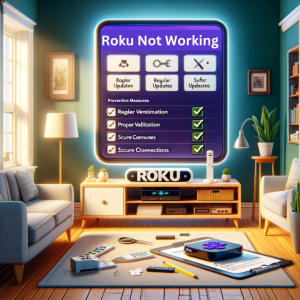
-
Proper Ventilation for Roku
Overheating can lead to Roku not working issue and potentially damage your device. Ensure that your Roku has proper ventilation by keeping it in a well-ventilated area, away from other heat-generating devices. Avoid placing it inside enclosed spaces or on top of other electronic equipment.
-
Safe Removal of Channels from Roku
If you have channels on your Roku that you no longer use, it’s a good idea to remove them to free up space and resources. To remove a channel, highlight it on your home screen, push the * button on your remote control, and choose “Remove channel.” Removing unused channels can help improve your Roku’s performance and navigation speed and prevent Roku not working problem.
FAQs
Q1. Why is Roku Not Working?
- A1. Common reasons for Roku not working include connectivity issues, software glitches, and hardware malfunctions such as no sound on Roku TV, TV not turning on, or problems with the Roku remote control. Identifying the specific issue is crucial for effective troubleshooting for Roku.
Q2. What should I do if there’s No Sound From Roku?
- A2. Ensure HDMI connections are secure, try different HDMI ports or cables, and check if your TV is on the correct input source. These steps can help resolve issue of no sound from Roku.
Q3. How can I fix my Roku if it’s freezing or performing slowly?
- A3. Clearing the cache by using a specific button sequence on your remote or removing unused channels can improve performance. Adjusting streaming quality settings may also help with issues related to Roku freezing and slow performance.
Q4. What steps can I take if my Roku TV won’t turn on?
- A4. Re-pairing your remote by removing the batteries, unplugging the Roku device, and then plugging it back in can resolve Roku TV not turning on issues. Checking and replacing batteries in the remote may also be necessary.
Q5. How do I troubleshoot a non-responsive Roku remote?
- A5. Start by re-pairing the remote with your Roku device. If the remote remains unresponsive, check for dead batteries and replace them if needed. The Roku mobile app can serve as a temporary remote control solution.
Q6. How can I prevent my Roku from having issues in the future?
- A6. Regular software updates, ensuring proper ventilation to prevent overheating, removing unused channels, and maintaining a strong internet connection are key preventive measures for Roku not working scenarios.
Q7. How do I check for and install Roku software updates?
- A7. Navigate to the settings menu, select “System,” then “System update,” and follow the on-screen instructions to install any available updates. Regular updates can fix bugs and enhance performance.
Q8. What should I do if my Roku is overheating?
- A8. Ensure your Roku device is placed in a well-ventilated area away from other heat-generating devices. Overheating can lead to performance issues and potential damage resulting in Roku not working.
Conclusion
Navigating the intricacies of Roku troubleshooting can initially seem daunting, but understanding the common issues and how to address them can greatly enhance your streaming experience. Whether you’re faced with Roku not working scenarios, such as no sound on Roku TV, TV not turning on, this guide has armed you with both basic and advanced Roku troubleshooting techniques to tackle these challenges head-on. By identifying the root cause of the issues and employing targeted solutions, you can often quickly return to enjoy your favorite content.
In addition to troubleshooting, adopting preventive measures plays an essential role in maintaining the best possible performance of your Roku device. Regular software updates, ensuring proper ventilation, removing unused channels, and maintaining a strong internet connection are key practices that contribute to a seamless and uninterrupted streaming experience. By being proactive about these aspects, you can minimize the likelihood of encountering Roku not working issues in the future.
Loaded with the knowledge from this comprehensive guide, you’re now better equipped to handle any Roku not connecting issue, ensuring that your streaming experience remains top-notch. Remember, most Roku problems have simple solutions, and with a bit of patience and troubleshooting, you’ll often find that getting back to your binge-watching session is just a few steps away.
To know more about Roku Not Working issue, visit our Roku Support Page.

Thomas nguyen
I’ve been experiencing persistent Roku not connecting issues, which disrupt my streaming experience. Could you guide me through the troubleshooting steps specifically for when my Roku does not work due to internet connectivity problems, and advise on how to prevent such issues from recurring?
Support Admin
When you encounter issues where your Roku does not work due to connectivity problems, start by checking the strength and stability of your Wi-Fi connection. Ensure that your router is functioning optimally and that your Roku device is within a strong signal range. Attempt to reconnect your Roku to the internet or perform a router restart to refresh the connection. To prevent future Roku not connecting problems, regularly monitor your internet speed, ensure your router’s firmware is up to date, and position your Roku device closer to the router for a stronger signal. Maintaining a stable and robust internet connection is key to avoiding connectivity issues.
Karen nelson
After updating my Roku, I’ve noticed there’s no sound on Roku TV while streaming. What specific steps should I take to troubleshoot and resolve this issue, and what measures can I implement to prevent it from happening again?
Support Admin
If you’re facing an issue where there’s no sound on Roku TV, first, check the HDMI connections between your Roku device and TV to ensure they are secure. Try using a different HDMI port or cable to see if the issue persists, indicating a potential hardware problem. Also, verify that your TV is set to the correct input source. To avoid future Roku no sound on TV problems, regularly inspect your audio settings after each update and ensure that your HDMI cables are in good condition. Keeping your Roku device’s software updated can also help prevent audio-related issues by fixing known bugs and improving compatibility.